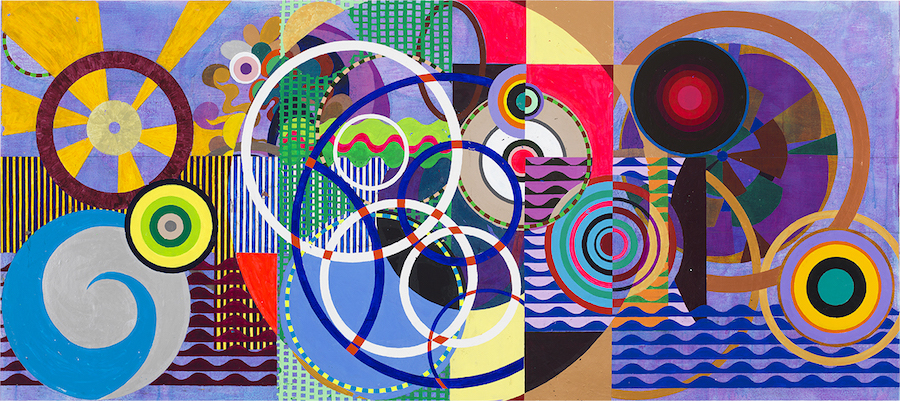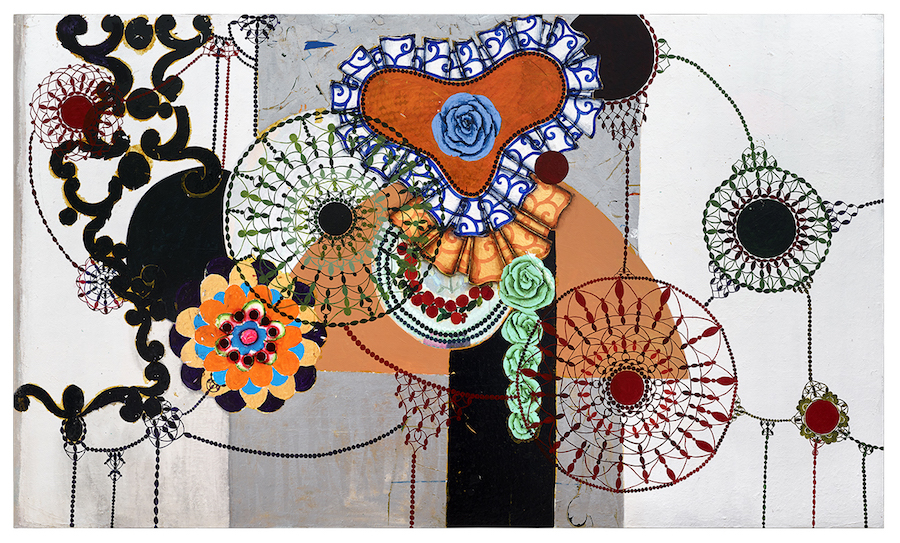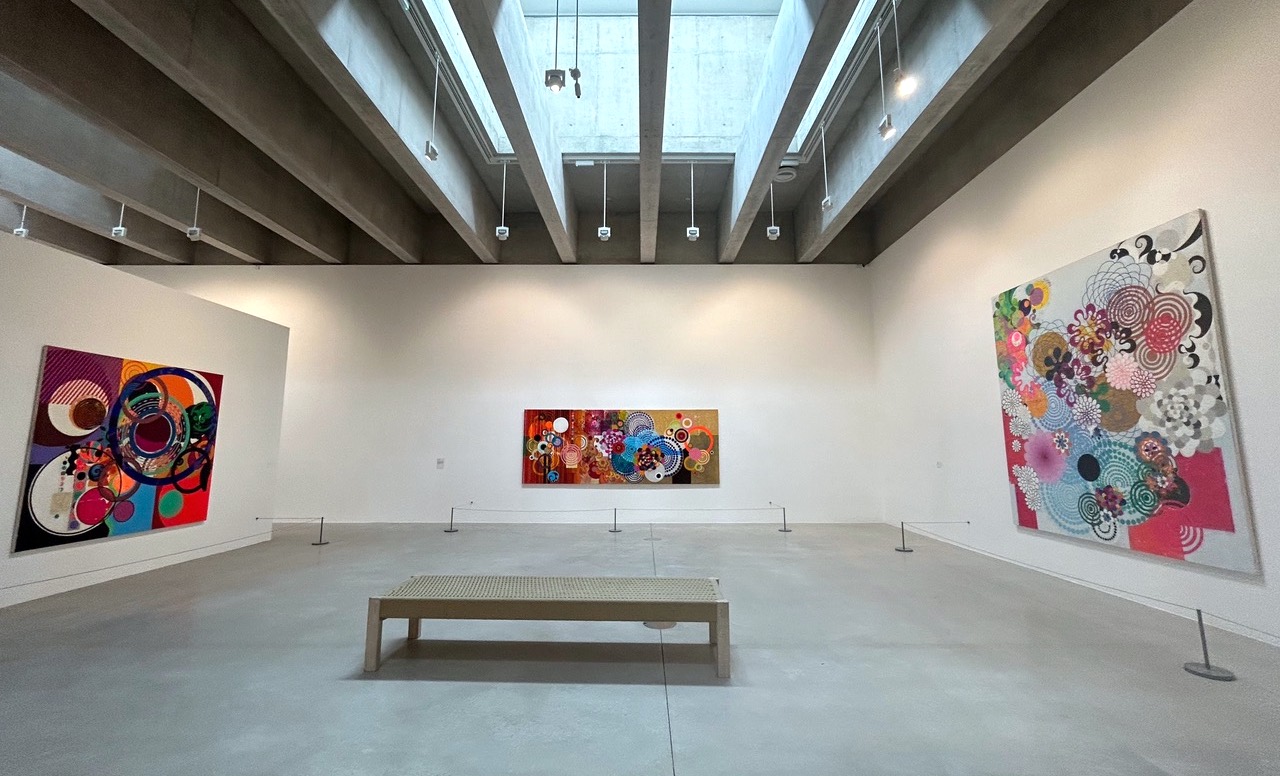Brazilian artist Beatriz Milhazes draws inspiration from the sea and nature of Rio de Janeiro. Maresias, her new exhibition at Tate’s outpost in the enchanting Cornish coastal town of St. Ives, was initially displayed at Turner Contemporary in Margate. Maresias is Portuguese for the salty sea breeze in the coastal city of Rio de Janeiro, where Milhazes lives and works.
One of the leading abstract artists working today, Milhazes has spent the past four decades creating a unique artistic practice combining applied arts with collage and painting. She is known for her joyful, large-scale abstract canvases. Beatriz Milhazes: Maresias traces the evolution of the artist’s distinctive paintings, and their relationship to nature and the sea feels more poignant through their display in the Tate’s St. Ives beachfront location.

Beatriz Milhazes says: “A survey show is a journey observing the complexity through a creative process, sometimes pleasant, sometimes painful, but always a special moment to celebrate life. The UK has been an especially supportive place for my work, and the exhibition ‘Maresias’ organised by Turner Contemporary and now exhibited at Tate St. Ives is a gift for me. It’s special for me to be in St. Ives and smell the sea salt breeze of the same ocean as Rio de Janeiro – same water, different culture – a connection with art and nature.”
Maresias is a vital survey show presenting a curated journey through four decades of Milhazes’s artistic journey. The Tate St. Ives galleries present the course of her work in different periods, with a strong group of paintings and collaged artworks. There is a strong visual connection with nature running through the exhibition and a connection to the ocean, which resonates even more through the display of the paintings in the high-ceilinged, light-filled galleries in Tate’s beachfront St. Ives location. Milhazes describes herself as ‘an artist from the Tropics’, and her paintings are infused with the ambience of Rio de Janeiro, humming with the sound of the sea and brimming with motifs inspired by the power of the waves and the ambience of the forest.
Maresias takes viewers on a visually stimulating journey through some of the most significant paintings and collages created by Milhazes since 1989. Milhazes experienced a breakthrough moment in 1989, which was instrumental to developing her style when she developed her signature ‘mono transfer’ technique to react to her frustration with the appearance of brushstrokes. Highlights of the exhibition are the monumental Maresias 2002, and also on display are several artworks featuring the monotransfer technique, which Milhazes exhibited in the Brazilian Pavilion at the 50th Venice Biennale. Her distinctive vocabulary of geometric shapes and arabesque lines is combined with a captivating palette that provides a momentary escape from reality into a more colourful, joyful universe.
Milhazes says: “Geometry organises my thought and imagination; I’ve been interested in the relation between nature and mathematics. My creative process is very rational, with an imaginary logic, built up as equations, thinking about the structure of nature and the history of art.”
Rio de Janeiro has been a constant source of inspiration to Milhazes throughout her career, and a unique visual alphabet of oceanic, floral and celestial motifs populates her abstract canvases.
Margate has inspired artists from Turner to Emin, and St. Ives has been a magnet for artists since Dame Barbara Hepworth moved there from London with her young family in 1939 to escape the bombings during World War II. So it isn’t as unlikely as it might seem for a Brazilian artist from a tropical seaside destination to exhibit in two iconic British seaside towns where the ocean and the magical light have acted as magnets to artists for centuries.

Tate St Ives Director Anne Barlow curated the exhibition and explained: “The title of the exhibition ‘Maresias’ is ‘Salty Sea Breeze’ so it speaks to both our locales (Margate and St. Ives) in a way, and feels appropriate to have the exhibition in St. Ives.”
Milhazes is riding the crest of a wave of women artists finally receiving the recognition they deserve through solo exhibitions and retrospectives at world-class museums and galleries. As Milhazes opens at Tate St. Ives, Yoko Ono is exhibiting at Tate Modern, Judy Chicago at Serpentine Gallery, and Marina Abramovic was recently the first woman artist to have a solo exhibition in the main galleries of the Royal Academy of Arts.
Milhazes (born in 1960 in Rio de Janeiro) first impacted the art world as a founding member of the Geração Oitenta (1980s Generation). This Brazilian art movement broke from the conceptual art that had dominated the 1970s and pivoted towards painting as a dynamic form of artistic expression.
Milhazes represented Brazil at the 50th Venice Biennale (2003), participated in the São Paulo Biennial (1998, 2004) and the Shanghai Biennial (2006), and received a UK public commission from Art on the Underground (2005). Milhazes is participating in the 60th Venice Biennale at the V&A Applied Arts Pavilion.
Milhazes is influenced by multiple sources, including Catholic iconography, Brazilian and European modernism, Baroque colonial architecture, and Brazil’s heritage and vernacular culture. Other influences are found in her immediate surroundings, with the landscapes around her studio and forms in nature informing her imagery’s lexicon.

The paintings exhibited in Maresias are perfect examples of Milhazes’s ability to transfuse some of Brazil’s vibrant culture, spirituality, and heritage onto canvas with a unique visual alphabet and exuberant palette. Influences range from Copacabana Beach to the Tijuca forest and Rio de Janeiro’s Botanical Gardens.
Adapting the concept of collage to painting, Milhazes has conceived her signature technique by translating collage to painting to create multi-layered works. She developed her ‘monotransfer’ technique in 1989, as seen in many photographs at Tate St. Ives. Milhazes’s monotransfer process involves designing motifs and painting them onto plastic sheeting before transposing them onto canvas. Preferring to work with a bright, exuberant palette, often including fluorescent and metallic pigments, the monotransfer process enables Milhaze to retain the intensity of colours without losing the painterly, handmade quality.
Director Anne Barlow and Assistant Curator Giles Jackson curate the presentation of Maresias at Tate St Ives. Maresias originated at Turner Contemporary, Margate, and has been adapted for presentation at Tate St Ives.
Top Photo: Lee Sharrock © 2024
Beatriz Milhazes: Maresias is at Tate St Ives until 29th September 2024:

